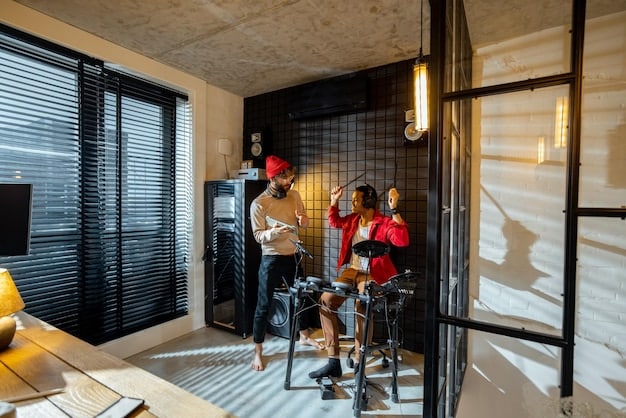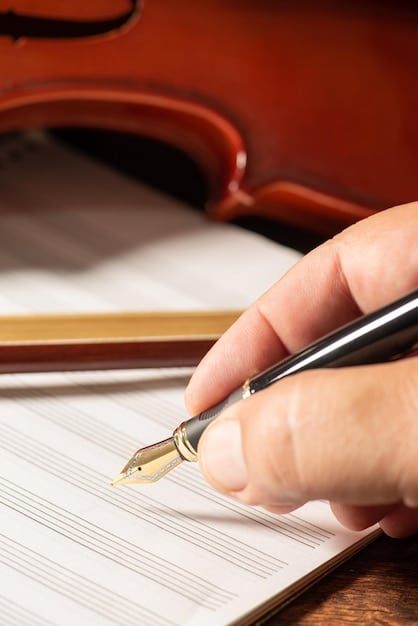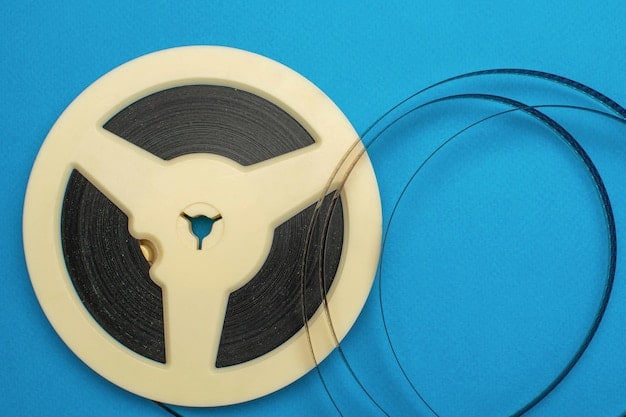Independent Labels: Navigating Music Licensing Complexities in the US

Independent Labels: How to Navigate the Complexities of Music Licensing in the US involves understanding copyright law, obtaining necessary licenses (mechanical, performance, synchronization), and effectively managing rights to ensure legal and profitable exploitation of musical works in the United States.
Navigating the music industry as an independent label can feel like traversing a complex maze, especially when it comes to music licensing. Understanding the intricacies of copyright law and obtaining the right licenses is crucial for protecting your artists and ensuring their work is legally and fairly compensated. This article will guide you through the essential aspects of Independent Labels: How to Navigate the Complexities of Music Licensing in the US, empowering you to make informed decisions and build a sustainable business.
Understanding Copyright Law for Independent Labels
For independent labels, a solid grasp of copyright law is the bedrock of ethical and legal operations. Copyright law in the United States grants exclusive rights to creators of original works, including musical compositions and sound recordings. This protection extends to various aspects of their work, such as reproduction, distribution, and public performance. Knowing these rights is essential to protect your artists and their intellectual property within the US music market.
Basics of Copyright
Copyright protection arises automatically upon the creation of an original work and its fixation in a tangible medium, such as a recording or sheet music. Understanding what constitutes copyrightable material and the duration of copyright protection is vital for navigating the legal landscape.
The Copyright Act of 1976, as amended, provides the framework for copyright law in the United States. It defines the scope of copyright protection and outlines the rights of copyright owners.
Protecting Your Music
As an independent label, you need to understand the differences between a sound recording (the actual recording of the song) and a musical composition (the underlying melody and lyrics). Each has different copyrights and requires different licenses.
- Registering your copyrights with the U.S. Copyright Office provides a public record of your claim and strengthens your legal position in case of infringement.
- Clearly label your recordings with copyright notices (© and ℗ symbols) to deter infringement and inform others of your ownership.
- Regularly monitor online platforms and other channels for unauthorized use of your music.

In conclusion, understanding copyright law is not merely a legal formality but a fundamental requirement for independent labels. By grasping the basics, protecting your music, and addressing infringement proactively, you can safeguard your creative assets and build a sustainable business in the US music market.
Key Types of Music Licenses
Navigating the world of music licensing requires understanding the different types of licenses and when they are needed. Independent labels must know the nuances of each license to avoid infringement and ensure proper compensation for artists.
Mechanical Licenses
A mechanical license grants permission to reproduce and distribute copyrighted musical compositions. These licenses are essential for activities such as pressing CDs, selling digital downloads, or streaming music on demand.
The Harry Fox Agency (HFA) and other collective rights organizations administer mechanical licenses on behalf of music publishers. Understanding how to obtain these licenses and calculate royalties is crucial.
Performance Licenses
Performance licenses are required when a musical composition is performed publicly. This includes radio airplay, live concerts, streaming services, and even playing music in a business establishment. These licenses ensure that songwriters and publishers receive royalties for the public performance of their work.
- Performance Rights Organizations (PROs) such as ASCAP, BMI, and SESAC collect and distribute performance royalties on behalf of their members.
- Understanding the scope of performance licenses and the role of PROs is essential for managing your label’s royalty obligations and revenue streams.
- Small businesses and venues also need to obtain performance licenses.
Synchronization Licenses
A synchronization license is needed to use a musical composition in a visual work, such as a film, television show, video game, or advertisement. Sync licenses are typically negotiated directly with the copyright owner of the musical composition (usually the publisher).

In conclusion, obtaining the necessary licenses is critical for independent labels to operate legally and ethically. By understanding the requirements for mechanical, performance, and synchronization licenses, labels can protect their artists and generate revenue from various sources.
Obtaining Mechanical Licenses
Securing mechanical licenses is a foundational step for independent labels aiming to distribute music legally in the US. These licenses grant the right to reproduce and distribute copyrighted musical works in various formats, from physical copies to digital streams.
Understanding the Process
The process typically involves identifying the copyright owner of the musical composition, whether it’s the songwriter, publisher, or administrator. The Harry Fox Agency (HFA) is a common resource for obtaining mechanical licenses, especially for US-based compositions.
Before distributing any music, it’s crucial to contact the copyright owner or HFA to request a mechanical license. This request should include details about the song, the intended use (e.g., CD, digital download, streaming), and the number of copies to be manufactured or distributed.
Navigating the Harry Fox Agency (HFA)
HFA simplifies the mechanical licensing process by acting as an intermediary between music publishers and those seeking to reproduce their music. Their services streamline the process for both parties, ensuring compliance and fair compensation.
- Start by searching HFA’s Songfile database to confirm that they administer the mechanical rights for the specific composition you want to license.
- Create an account on Songfile and follow the prompts to request a license, providing all necessary information about your intended use and distribution plans.
- Pay the required royalties, which are typically calculated based on the statutory rate per copy or stream.
Securing mechanical licenses, whether directly from copyright holders or through agencies like the HFA, is a critical step for independent labels. Approaching this process with diligence ensures legal compliance and respect for the rights of songwriters and publishers.
Navigating Performance Rights Organizations (PROs)
Performance Rights Organizations (PROs) play a pivotal role in the music industry by collecting and distributing royalties for the public performance of musical works. Understanding how PROs operate is essential for independent labels and artists.
Role of PROs
PROs like ASCAP, BMI, and SESAC represent songwriters and publishers, granting licenses to businesses that publicly perform music. These performances can include radio broadcasts, live concerts, streamed music, and music played in restaurants and stores.
When a musical work is publicly performed, the venue or platform pays a licensing fee to the PRO. The PRO then distributes these royalties to the copyright holders of the musical composition. This system ensures that songwriters and publishers are compensated for the use of their work.
Key PROs in the US
The three main PROs in the United States are ASCAP (American Society of Composers, Authors and Publishers), BMI (Broadcast Music, Inc.), and SESAC (Society of European Stage Authors and Composers). Each PRO has its own membership requirements, fee structures, and distribution methods.
- ASCAP is a member-owned organization that collects and distributes performance royalties based on a survey system that tracks music usage.
- BMI operates as a non-profit organization and also uses a survey system to determine royalty payments.
- SESAC is a for-profit company that uses a combination of census and sample-based methods to determine royalty payments.
Navigating PROs effectively involves understanding their roles, registering your works, and monitoring performance royalties. By engaging with PROs, independent labels can ensure fair compensation for their artists and foster a sustainable music ecosystem.
Understanding Synchronization Licenses
Synchronization licenses, or sync licenses, are critical for independent labels that want their music to appear in visual media. These licenses grant permission to synchronize a musical work with visual images, such as in films, TV shows, video games, or advertisements.
Securing Sync Licenses
Obtaining a sync license involves contacting the copyright owner of both the musical composition (usually the publisher) and the sound recording (usually the record label). Unlike mechanical licenses, sync licenses are negotiated directly with the copyright holders.
The process typically starts with a request from the filmmaker, TV producer, or advertiser outlining the intended use of the music, including the length of the song to be used and the context in which it will appear. The copyright holders then evaluate the request and negotiate a fee based on factors like the popularity of the song, the scope of the project, and the prominence of the music in the visual work.
Negotiating Sync License Fees
The fees for sync licenses can vary widely, ranging from a few hundred dollars for small, independent projects to tens of thousands of dollars for major films or commercials. Factors influencing sync license fees include:
- The type of media (film, TV, advertisement, video game).
- The prominence of the music (background, featured, theme song).
- The duration of the music used.
- The territory in which the visual work will be distributed.
Understanding and securing sync licenses is crucial for independent labels to maximize their revenue streams and increase exposure for their artists. Approaching negotiations with clear knowledge of your rights and the value of your music can lead to successful and mutually beneficial agreements.
Strategies for Independent Labels in Music Licensing
To thrive in the complex landscape of music licensing, independent labels need to adopt strategic approaches that protect their rights and maximize revenue opportunities. These strategies involve proactive planning, diligent management, and continuous education.
Building Relationships
Establishing strong relationships with music publishers, PROs, and licensing agencies can significantly benefit independent labels. These relationships can provide access to valuable information, streamline the licensing process, and open doors to new opportunities.
Networking at industry events, attending workshops, and actively engaging with key players can help build these essential relationships. Regular communication and a collaborative approach foster trust and mutual understanding, leading to more favorable outcomes.
Leveraging Technology
Technology can streamline many aspects of music licensing, from tracking royalties to managing copyright information. Digital tools and platforms are available to help independent labels efficiently handle these tasks.
- Copyright management software can help track and manage your music catalog, ensuring accurate and up-to-date information about your copyrights.
- Royalty tracking systems can monitor and reconcile royalty statements, helping you identify discrepancies and ensure you are receiving fair compensation.
- Online licensing platforms can connect you with potential licensees, making it easier to find opportunities for sync licensing and other uses of your music.
Adopting a strategic approach to music licensing, by building relationships and leveraging technology, is essential for independent labels. These strategies not only protect your rights but also maximize your revenue potential and ensure long-term success in the music industry.
| Key Point | Brief Description |
|---|---|
| 🎵 Copyright Basics | Understanding copyright protects your music. Register and label it carefully. |
| 💼 License Types | Mechanical, Performance, and Sync licenses have distinct uses and requirements. |
| 💰 PROs Role | ASCAP, BMI, and SESAC collect performance royalties for artists and publishers. |
| 🤝 Relationships | Build connections in the industry for smoother licensing processes. |
Frequently Asked Questions (FAQ)
▼
A sound recording is the specific recorded performance of a song, while a musical composition refers to the underlying melody and lyrics. Each has separate copyrights and requires different licenses.
▼
You can obtain a mechanical license through the Harry Fox Agency (HFA) or directly from the copyright owner of the musical composition. This license allows you to reproduce and distribute the song.
▼
PROs like ASCAP, BMI, and SESAC collect and distribute performance royalties on behalf of songwriters and publishers. They ensure that artists are compensated when their music is performed publicly.
▼
A synchronization license is required whenever you want to use a musical composition in a visual work, such as films, TV shows, video games, or advertisements. This license grants permission to sync the music with the visuals.
▼
Independent labels can maximize revenue by understanding different types of licenses, building relationships with PROs and publishers, and actively seeking opportunities for sync licenses and other uses of their music.
Conclusion
Navigating the complexities of music licensing in the US is critical for independent labels aiming to thrive in the music industry. By understanding copyright law, securing the necessary licenses, and employing strategic approaches, labels can protect their artists’ rights, maximize revenue streams, and build a sustainable future.





